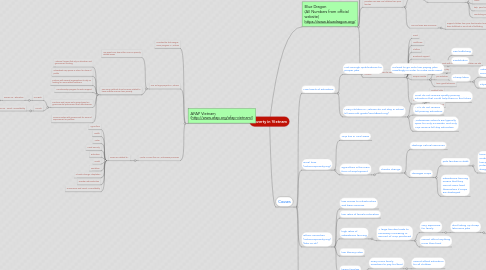
1. AFAP Vietnam (http://www.afap.org/afap-vietnam/)
1.1. Provides the first Dengue Fever program in Vietnam
1.2. Has 30 large projects in Vietnam
1.2.1. Has spent over $30 million USD on poverty related issues
1.2.2. Has many methods to solve issues related to lower-middle income class' poverty
1.2.2.1. Maternal houses that rely on donation and government funding
1.2.2.2. Subsidised crop prices in return for share of profits
1.2.2.3. Partners with several organisations to rely on funding for issue-related solutions
1.2.2.4. Has internship program for extra support
1.2.2.5. Produces and carries out surveys based on governmental policies and their effectiveness
1.2.2.5.1. Hoa Binh
1.2.2.5.2. Ha Tinh
1.2.2.6. Communicates with government for areas of improvement on policies
1.3. Works in more than 20 Vietnamese provinces
1.3.1. Issues are related to...
1.3.1.1. Agriculture
1.3.1.2. Health
1.3.1.3. Water
1.3.1.4. Food Security
1.3.1.5. Education
1.3.1.6. Credit
1.3.1.7. Sanitation
1.3.1.8. Climate Change Adaptation
1.3.1.9. Disaster Risk Reduction
1.3.1.10. Governance and Social Accountability
2. Blue Dragon (All Numbers from official website) https://www.bluedragon.org/
2.1. rescued 362 children trafficked for child labour in Vietnam
2.1.1. locate children who have been trafficked
2.1.2. rescue these children directly out of the sweatshops
2.1.2.1. Ho Chi Minh City
2.1.3. bring trafficked children back to their families
2.1.3.1. counceling
2.1.3.2. school support
2.1.4. We work with families and local authorities to raise awareness about trafficking and child labour
2.1.5. We assist the Vietnamese police to prosecute the traffickers and support victims through the process
2.2. rescued 104 young trafficked woman
2.3. provides over 850 rural children from poor families
2.3.1. Bac Ninh
2.3.1.1. poorest province in North East Vietnam
2.3.1.2. works with local schools and authorities
2.3.1.2.1. identify the poorest families and develop a plan for the children to attend school in their home villages.
2.3.1.2.2. prevent children from dropping out of school and potentially living in danger on the streets of Hanoi.
2.3.1.2.3. help poor families build or renovate houses
2.3.1.2.4. conducting workshops in schools
2.3.2. Hue and Dien Bien Provinces
2.3.2.1. support children from poor families who have been trafficked or are at risk of trafficking
2.3.2.1.1. Financial support
2.3.2.1.2. Learning Support
2.4. provide emergency care for 400+ vulnerable children
2.4.1. Food
2.4.2. Healthcare
2.4.3. Clothes
2.4.4. Emotional Support
2.4.5. Bring runaways home
2.4.5.1. work with families to ensure children are safe
2.4.6. Drop-in Centre
2.4.6.1. a place to play
2.4.6.2. join activities
2.4.6.3. learn good behaviour
2.4.7. Activities
2.4.7.1. Football Club
2.4.7.2. Swimming Lessons
2.4.7.3. Rock Climbing
2.4.7.4. etc.
3. Causes
3.1. Low levels of education
3.1.1. Not enough qualifications for proper jobs
3.1.1.1. Inclined to go onto low paying jobs unwillingly in order to make ends meet.
3.1.1.1.1. Sex trafficking
3.1.1.1.2. Prostitution
3.1.1.1.3. Cheap labor
3.1.2. Many children in Vietnam do not stay in school till even 5th grade [worldbank.org]
3.1.2.1. Most do not receive quality primary education that could help them in the future
3.1.2.2. ~1/3 do not receive full primary education
3.1.2.3. Vietnamese schools are typically open for only 33 weeks, and only 10% receive full day education
3.2. Rural lives [actiononpoverty.org]
3.2.1. 75% live in rural areas
3.2.2. agriculture is the main form of employment
3.2.2.1. climate change
3.2.2.1.1. destroys natural resources
3.2.2.1.2. damages crops
3.3. Ethnic minorities [actiononpoverty.org] [bbc.co.uk]
3.3.1. less access to infrastructure and basic services
3.3.2. low rates of female education
3.3.3. high rates of subsistence farming
3.3.3.1. + large families leads to necessary increasing in amount of crop produced
3.3.3.1.1. very expensive for family
3.3.3.1.2. cannot afford anything more than food
3.3.4. low literacy rates
3.3.5. larger families
3.3.5.1. many more family members to pay for/feed
3.3.5.1.1. cannot afford education for all children
3.3.5.2. less capability to take care of many children
3.4. Life in the mountains [actiononpoverty.org] [bbc
3.4.1. scarce of poor topsoils
3.4.2. inaccessibility/lack of road maintanence
3.4.3. fewer shops or markets to sell things
3.4.3.1. cannot sell crops even if they overcome subsistence farming
3.4.4. increases in harsh weather
3.4.4.1. climate change
3.4.4.1.1. landslides
3.4.4.1.2. flash floods
3.4.4.1.3. drought
3.4.4.1.4. storms

